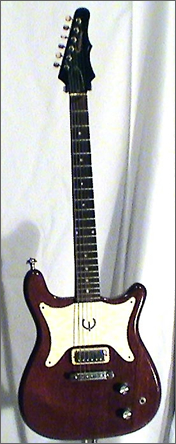 The Epiphone Coronet was launched in 1958 as an alternative to the popular Gibson Les Paul Junior. It was part of a range of models made from the late 50s to 1970. The range included the Crestwood, Coronet  and Olympic models.
The Epiphone Coronet was launched in 1958 as an alternative to the popular Gibson Les Paul Junior. It was part of a range of models made from the late 50s to 1970. The range included the Crestwood, Coronet  and Olympic models.
The models were designed to compete with the Gibson Les Paul Junior, and so they all had slim mahogany bodies and necks, and were made in a slightly offset double cutaway format.
The guitars resembled a cross between a Fender Telecaster and a twin-cutaway Gibson Les Paul Junior. The Coronet had a single “dog-eared†P-90 pickup at the bridge. The Olympic had one-single-coil pickup, like a Gibson Melody Maker, while the Crestwood, available as a Custom or Deluxe model, had two or three mini-humbuckers depending on model. The guitars had an optional Epiphone Trem-O-Tone vibrato, similar to the Bigsby unit widely used by Gibson.
The Coronet is the best-known of the range and is known as a very simple, playable instrument which is well built and has a classic single P-90 tone like a Gibson Les Paul Junior, which was the original target for the guitar.
Coronets are quite rare, as they never achieved the success they set out to have. An original will cost anything from £750 to £1500.
Epiphone no longer make any of these models, and the closest to a new one is the limited run of “USA Coronets†made in the 1990s. However, these are nothing like the originals, and only share the shape of the 1960s models.
The USA models had optional Floyd Rose tremolos, Bill Lawrence pickups and an array of vibrant finishes. These will be anywhere from £400 – £750.

One reply on “Collectable Guitars pt 14 – The Epiphone Coronet”
I have a 1963 Coronet, that looks just like the one pictured above, but mine has the optional vibrato. I got it new, in Hibbing, Minnesota, when I was 13 years old, from Liabraten’s music store. It is like new, in the original case, and I was surprised to see how valuable that they have become.